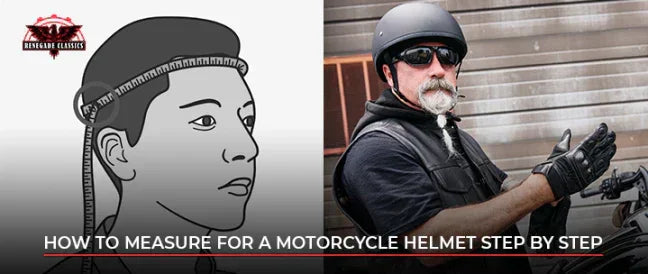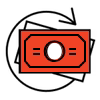To measure a motorcycle helmet size accurately, follow this simple four-step procedure. But before diving in, it’s important to understand the importance of proper sizing. Consider your favorite shirt that you just purchased. Just as a shirt that's too tight or too loose can ruin your appearance, an ill-fitting helmet can spoil your ride—especially if you’re a bike enthusiast. It can even jeopardize your life by increasing the risk of injury to sensitive areas of the head, or leave you confined to bed for days. On the other hand, a snug-fitting helmet ensures safety and lets you enjoy countless rides. Taking into account the importance of the perfectly sized helmet, we have crafted a comprehensive blog on a motorcycle helmet sizing guide. Let us start.
Step-by-Step Procedure To Measure A Motorcycle Helmet For a Perfect Fit:
Ready to get a snug fit for motorcycle helmets? The process is simple and takes only a few minutes, helping you choose a helmet that ensures both safety and comfort.
Here’s the four-step procedure to follow:
1- Opt for a helmet style
2- Determine the head shape and size
3- Wear on the helmet
4- Give it a go on a 45-minute ride
1- Choosing the Helmet Style:

This step can be tricky, especially for passionate riders. Nowadays, there are dozens of helmets out there, from different brands, each one offering a distinct flair and unique benefits. With so many choices, it’s tempting to collect multiple helmets to show off your riding style. But you don’t have to burn a hole in your pocket, and should go for 1 or 2 units only. Keeping things simple, there are six basic types of helmets you can choose from, which are below:
1.1- Full-face helmet:

As its name suggests, a full-face helmet offers holistic coverage to your head area, including the chin and face. These helmets are ideal for highway riding, sports and touring, and furnish maximum protection from wind, rain and sunlight.
1.2- Modular Helmet:

It resembles a full-face helmet but comes equipped with a flip-up chin bar. Blending convenience and safety, a modular helmet is suitable for bikers who ride in a group and communicate with their members.
3- Open-face Helmet:

Ideal for casual riders, this helmet involves a trade-off of safety for ventilation and lightness. It offers no chin protection; thus, it is unbefitting for endurance riding.
4- Half Helmet:

This helmet only covers the top portion of the head, which is ideal for summer. However, when it comes to offering safety, the half helmet falls flat.
5- Dual-Sport Helmet:

If you are an adventure rider, this helmet is in the cards for you. Featuring an extended visor and flip-down shield, it offers convenience to both highway and off-road riding conditions.
Depending on your needs, style and preference, you can finalize a gear-piece from these categories. Let us move towards the next step:
2- Determine The Head Shape and Size:

After selecting the helmet type, the next step in measuring for a helmet is identifying your head shape. Generally, a majority of people in the USA fit into one of these three categories: intermediate oval, round oval, long oval and neutral oval. To accurately determine your head shape, ask your friend or a family member to snap a photo from right above the head while you are sitting upright. A good practice is to flatten your hair before being photographed; it will prevent misleading measurements caused by extra volume of hair.
2.1 Head Size Measurement:
To get an accurate record of your head, you need a cloth measuring tape. Easy Follow these instructions:
1- Wrap the measuring tape one inch above the eyebrows and record the measurement. The area over your eyebrows accounts for the largest circumference of the head, helping to get a decent fit that doesn’t feel excessively tight.

2- Now compare this measurement with the standard size chart reading and order the helmet accordingly.

Here is the standard helmet size chart you can refer to while seeking the right fit.
Match the Measurement:


Instantly Check your Helmet Size in 2 sec
Difference In Measurement Techniques With Change In Head Shape
The measurement method we set forth in the last paragraph holds accuracy for round head shapes. If your head shape is long oval or intermediate, use the following ways to wrap the measuring tape.
1- Longer Oval Shape:

Wrap the tape crosswise, as it accounts for the largest part of the head. A straight wrap, in this case, may lead to under sizing of the helmet.
2- Intermediate Oval Shape:
Wrap the tape level around the skull and rear tape position should be around the occipital bump( a bump lying in the lower side of the head) for an immaculate fit.
In case the measurement doesn’t coincide with any exact size on the chart, you can opt for the bigger size. Don’t worry! You can add extras later to get a snug fit.
Where to order a snugly-fitting helmet?
Getting the right size for your new helmet is just one part of the equation. You need to act wisely while seeking the brand, because there are dozens of manufacturers out there who focus more on profit than quality. by selling helmets that don’t cut it at all. Before you begin with the research, we want you to give Renegade Classics a go; Our helmets[ internal link to helmet collection] speak volumes in terms of durability, comfort and excellent rider-focused design.
Point to Ponder!
Do you know that helmets also expire? According to USA helmets manufacturers, the helmet should be changed after 5 years. If you want to explore the expiration of helmets, we recommend reading this blogpost as it will walk you through shocking facts that most riders don’t know.
Do Helmets Expire? Facts That Will Open Your Eyes For Good
3- Give Helmet A Try:
Just received a shiny new helmet and can’t stop admiring it? But you will forget the shimmer if it doesn't bring comfort as you ride wearing it. Time to see how well it fits. Put on the helmet and see how it feels. Any discomfort or pain disqualifies the wearable as unbefitting, which means you should go for another size. However, if it feels right, keep it worn for almost 15-30 minutes. During this time, relax and watch your favorite motorcycle race. Make sure you can effortlessly open your mouth even if the chin straps are tightened to a moderate extent.
After half an hour, you can take off the helmet to look for a few signs. If you see a big red line on the forehead as you stand in front of the mirror, Try a different size—typically one size up.
3.1- Go On A Ride With the helmet:
This is the phase where the rubber meets the road. You will figure out how the helmet performs when you cruise through sharp curves and turns. It should rest comfortably on the head, without coming off or frequently shifting its position. Within a period of 2 days, the helmet will gradually mold your head profile and should feel comfortable because its size has been accurately measured before.
Mistakes to Avoid When Measuring the right size for a new helmet
1- Failure to determine the head shape:
A lot of riders trip up at this point by misjudging the shape of their noggin. To avoid making this mistake, keep a head shape chart that contains photographs from the top angle. Match your head style with the photo chart, and then attribute a shape to your noggin.
2- Using a faulty measuring tap:
Ensure the measuring tap you use is properly calibrated so that the chances of wrong measurement are almost zilch.
Helmet Size Difference Between Male and Female Riders
1-Shape Differences:
Specifically in the USA, the female head shape tilts towards round when compared to male noggin anatomy.
2-Hair considerations:
Women have thick and long hair, which impacts helmet fit and may require adjustments for a comfortable fit.
Final Words:
Measuring motorcycle helmet size in an accurate manner means enhanced comfort and safety during the ride. Follow the measurement carefully and you will enjoy the fit— no wobbling, no displacement even if you cruise through strong winds or sharp turns.
Frequently Asked Questions
Q1-Should A Helmet be Tight?
Ans: No, a helmet should fit snugly. A tight helmet causes discomfort on pressure points, which can impact the quality of your ride. In a similar vein, it shouldn’t be too loose that it comes with the head during sharp turns.
Q2- Are half helmets as safe as full helmets?
Ans: No, half helmets are as safe as full helmets, because they do not offer a high level of protection to jaw, face and head.
Q3- What size helmet do I need for a 22 inch head?
Ans: A medium size helmet will give a snug fit according to your head size. You can still verify the size by referring to the head size chart.








